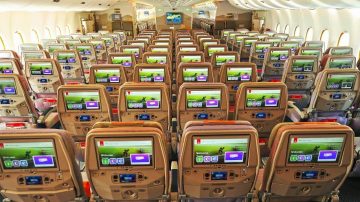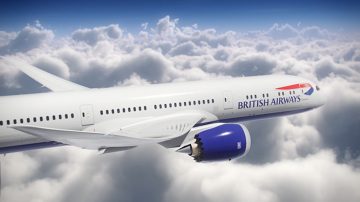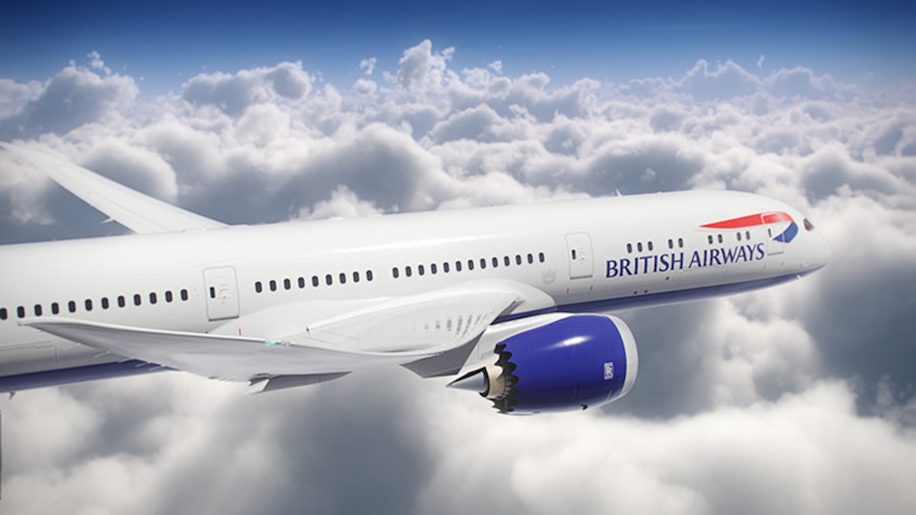
This month marks a new chapter for British Airways. On September 1, its new Dreamliner aircraft is to commence commercial flights to Toronto, with New York Newark following on October 1. At the same time, the airline’s new A380 superjumbo will also start flying, with initial routes down as Los Angeles (from September 24) and Hong Kong (October 22).
The new aircraft are important for both BA and its passengers for a number of reasons. First, they are part of a significant investment – the airline has committed to spend some £5 billion between now and 2017, including 12 A380s and 24 B787s, with a further 18 B787s (including 12 B787-10s) and 18 A350 orders in the book. As chief executive Keith Williams has pointed out, over the next 15 months BA “will take delivery of new aircraft at the rate of one a fortnight”.
It means that as the A380s arrive, the carrier can retire some of its B747-400 jumbo jet fleet and, as the B787s are added, it can start to replace its 14 long-haul B767s, which it hopes to retire by 2017 at the latest. This will also have the effect of gradually lowering the age of the BA fleet, where currently the average aircraft is 13 years old.
For passengers, it means newer aircraft with the airline’s latest onboard seating and in-flight entertainment (IFE) products, as well as a better flying experience.
In addition, the new aircraft will allow BA to operate routes that perhaps would not have been viable with less efficient planes. Speaking about the B787, Andy Lord, BA’s director of operations, says: “Because of its capability and range, it’s an ideal plane to open new markets – be that in the Far East, Africa or South America, if we choose to do so.”
Lastly, while it’s debatable whether aviation will ever be regarded as environmentally friendly, the A380 and B787 are considerably more efficient and quieter than their predecessors.
CONFIRMED ROUTES
B787:
- Toronto – September 1
- Newark – October 1
A380:
- Los Angeles – September 24
- Hong Kong – October 22
- Johannesburg – February 12, 2014
B787
British Airways is set to start flights from September 1 with its new B787 Dreamliner aircraft. With its scalloped edging around the engines, flexible wings and dimmable windows, it’s a stunning aircraft, and at the cutting edge of aviation – though some of its new technology is still being worked out, hence the grounding of the aircraft for several months earlier this year.
For the passenger, the seating on board will be familiar, with 214 passengers carried in three classes. Club World is configured 2-3-2 in two cabins, the arrangement meaning there is a single, backward-facing seat in the centre. Premium economy (World Traveller Plus) and economy (World Traveller) are both the “new” versions some passengers may have encountered on the airline’s B777-300ER fleet (and reviewed at businesstraveller.com/tried-and-tested).
World Traveller Plus has 25 seats in a 2-3-2 configuration, each offering 38 inches of legroom, IFE touchscreens measuring 10.5 inches, with noise-cancelling headphones, a power socket compatible with UK/US/EU plugs and two USB sockets.
World Traveller is in a 3-3-3 layout, in the rear two cabins, and also has the new Thales IFE system, with power sockets at the seats.
B787 AT A GLANCE
- List price B787-800 US$206.8 million; B787-900 US$243.6 million
- Seats 214
- Length 56.7 metres
- Wingspan 60 metres
- Width 5.49 metres
- Height 16.9 metres
- Engines Two Rolls-Royce Trent 1,000
- Maximum speed 954km/ph (Mach 0.89)
- Range 15,200km
A380
Quieter than a B747-400 and more fuel-efficient, thanks to better aerodynamics, wing technology and the use of advanced materials such as carbon fibre, the superjumbo offers a potential 15 per cent saving per passenger compared with other similar size wide-body aircraft, according to Airbus.
BA’s version of the superjumbo is configured for 469 passengers across four cabins. On the main deck there are 14 seats in First disposed 1-2-1, 44 Club World seats in a 2-4-2 configuration, then 199 World Traveller seats in a 3-4-3 layout. The upper deck has 53 Club World seats disposed 2-3-2, 55 World Traveller Plus seats in a 2-3-2 layout, and 104 World Traveller seats (2-4-2).
The First cabin is the “new First” which was introduced in 2010, but offers 30 per cent more space and 60 per cent more storage than the existing product, including a full-sized wardrobe. The leather seat is smart, with the elegance of a luxury car, and converts to a fully-flat bed.
Each seat has a 15.5-inch Thales IFE touchscreen (the same as on the B777), noise-cancelling headphones, personal in-seat power compatible with UK/US/EU plugs and two USB sockets.
Club World seating is offered in a new dark-blue colour scheme. Some tweaks have been made to the seat, including an improved footstool for easier use with three positions for taxiing, take-off and landing; redesigned, easier-to-use controls for seats; and a new, easy-to-find button to operate the privacy screen.
The seat converts into a 72-inch (182cm) fully-flat bed with a 12-inch screen and noise-cancelling headphones. There is also in-seat power and two USB sockets. On the upper deck, side storage areas run the length of the aircraft, offering customers in window seats extra stowage, capable of storing a laptop.
World Traveller Plus has a seat pitch of 38 inches and, as it is located on the upper deck, passengers in window seats can take advantage of side locker storage. IFE monitors are 10.5 inches and are touchscreen, with noise-cancelling headphones provided. Each seat has a power socket and two USB ports. There is a pre-take off choice of sparkling wine or non-alcoholic drinks, and entrées now come from the Club World menu.
All seats in economy have a 31-inch pitch and nine-inch seatback screens installed with the new Thales IFE system, as well as power points (UK/US/EU) and USB connectivity. Seats on the main deck are 3-4-3 but the cabin is wide (6.54 metres) and the upper deck seating is in a spacious 2-4-2 layout.
The upper-deck rear section may be noisier as it is located near the largest galley on the aircraft, but the cabin is small and intimate, with a better staff-to-passenger ratio, as well as the advantage of side storage for window seats.
A380 AT A GLANCE
- List price US$403.9 million
- Seats 469
- Length 72.7 metres
- Wingspan 79.8 metres
- Main deck width 6.54 metres
- Upper deck width 5.8 metres
- Height 24.1 metres
- Engines Four Rolls-Royce Trent 900
- Maximum speed 945km/ph (Mach 0.89)
- Range 15,400km (London-Perth is around 14,464km)
HOW THE AIRLINES COMPARE
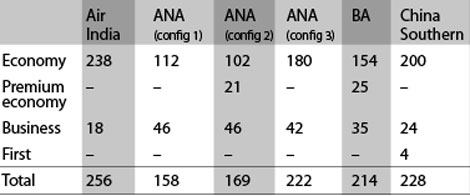

A380
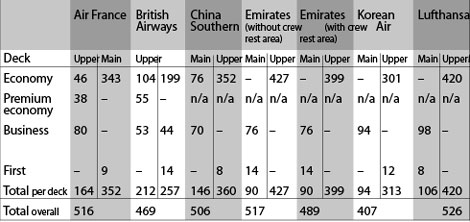
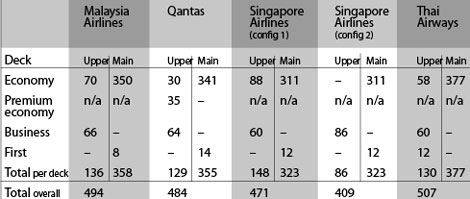
WHO’S UP NEXT?
There are more than 40 customers still waiting for their first Dreamliner, including Air Berlin, Air France-KLM, Air New Zealand, American Airlines, Delta Air Lines, Etihad Airways, Korean Air, Qantas, Royal Jordanian, Singapore Airlines and Virgin Atlantic.
A380
- Asiana Airlines – 2014
- Etihad Airways – 2014
- Qatar Airways – 2014
- Skymark Airlines – 2014
- Hong Kong Airlines – 2015
- Transaero Airlines – 2015
- Virgin Atlantic – 2018










